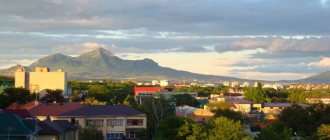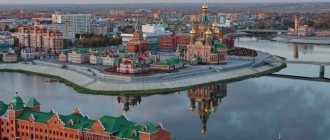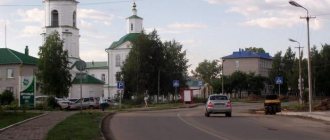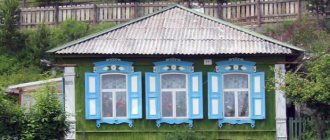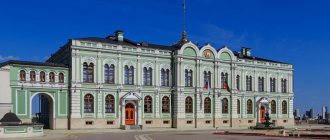The city of Mozhga in the southwest of Udmurtia
The city of Mozhga is located in the southwestern part of the Udmurt Republic on the Mozhginskaya Upland, in the valley of the non-navigable and non-floating Syuginka River (a tributary of the Vala), on the Kazan-Sverdlovsk (now Yekaterinburg) railway.
Mozhga is surrounded by forests from the north, south and west. The city was founded in 1825 as a settlement at the Syuginsky glass factory, a famous manufacturer of glass, jugs and animal figurines. The name of the plant based on its location on the Syuga River. After 1917, the village of Sovetsky, later the village of Krasny. Mozhga has been a city since 1926.
The first name was an ideological stamp; modern - associated with the name of one of the largest clan associations of the Udmurts, which lived in these places. Mozhga is a significant industrial center in the southwestern part of Udmurtia.
The most developed industries are glass, food, wood processing and forestry. Main attractions: Museum of History and Local Lore, Museum "Alarm of Memory", Ethnographic Museum "Udmurt Folk Art", People's Museum of Heroes of the Soviet Union - Defenders of the Brest Fortress and Saburov partisans, Temple of the Archangel Michael (the first brick building of the city), Museum, first street of the village Oktyabrskaya, , .
In terms of population, the city is of medium size: in the Udmurt Republic it is inferior to Izhevsk, Sarapul, Votkinsk, Glazov, leaving behind only Kambarka. From the capital of Udmurtia to Mozhga there are 93 kilometers by rail. Other nearby cities are Vyatskie Polyany (90 km), Sarapul (116), Glazov (297), Kazan (233), Perm (442), Kirov (405 km). Moscow is 1036 kilometers away.
Mozhga is connected to the country's heavy transport route. This indicates the advantageous geographical location of the city, as well as the opportunity for broad economic, cultural and other ties with the whole country. Paved roads connect Mozhga with Izhevsk, Elabuga, Naberezhnye Chelny, and other cities and towns. For the southwestern part of Udmurtia, Mozhga is the most important economic and cultural center.
Information from the Great Soviet Encyclopedia (vol. 16, p. 412, 1974): “Mozhga is a city of republican (ASSR) subordination in the Udmurt ASSR. Railway station on the Kazan-Agryz line. 38.9 thousand inhabitants (1970). It grew during the years of Soviet power from a small village that arose in the middle of the 19th century (the city - since 1926). Glass, tanning-extract and machine-building factories, sawmill and furniture plant. Veterinary College, Medical and Pedagogical Schools.”
Where did the name itself come from - Mozhga?
For clarification, let us turn to the article by S. Masalova, a researcher at the Mozhginsky Museum of Local Lore, “Where did our name come from” (“Mozhginskiye Vesti.” 1999, June 10).
“A long time ago, when the tribal system still existed, one of the tribes of the southern Udmurts settled in the lower reaches of the Vala River. The leader of this tribe was Mardan Batyr. The descendants of Mardan and his tribe year after year conquered new lands from the dense forest. This is how settlements (villages) arose.
One of Mardan’s sons, Mozhga, in search of fertile lands, reached the Nysha River, stayed to live here and laid the foundation for the village named after him. It is assumed that on the site of the village of Mozhgi there was a camp of Kama Bulgars before the Udmurts.
From the middle of the 18th century Mozhga
began to be settled by Russians, the Christianization of the Udmurt people began. For this reason, many left the village and formed new villages. This is how Udmurt Syugail, Upper and Lower Vishur, Chebershur, Chumoitlo, Chezhest, and Kinyagil appeared. At the same time, purely Russian villages grew: Cherny Log, Bikbai, Izhnyuk and others. In 1787, a stone church began to be built in Mozhga. It was consecrated during the Patriotic War of 1812.
In 1843, a parish school was opened in the village.
The village was densely populated
there were many two-story houses. The population was engaged in agriculture and cattle breeding. Crafts were well developed: blacksmithing, leather dressing, extraction of resin and tar, they made bast and matting for sale.
In the 19th century, Mozhga was a large trading village.
There were over a dozen shops here, crowded markets gathered on Sundays, and fairs were held twice a year. The people lived very frugally. We tried to do without buying industrial goods.
On May 8, 1924, the village was almost completely burned due to a fire.
The construction of the district center began near the Syuginsky glass factory. And the village was gradually rebuilt and is still thriving on the beautiful banks of the Nysha.”
Vichuzhanin A.G. Mozhga. Town above the Syuginka River
/ A.G. Vichuzhanin. – Izhevsk: Udmurtia, 2001.
The book tells about the history of the emergence and development of Mozhga. The author of the book is Honored Worker of Public Education of the Ural Republic A.G. Vichuzhanin talks about people who left their mark on the history of the city, industrial and social facilities, public education, culture, and healthcare.
Source
Name
The leader of one of the tribes of the southern Udmurts who settled in these parts was Mardan-Batyr. One of his sons, Mozhga, in search of fertile lands, reached the Nysha River, stayed to live here and founded a village that was later named after him. Much later, the city inherited its name from the village.
The city of Mozhga is a large industrial and interdistrict cultural center of the southwestern part of Udmurtia. The city is located on the Mozhginskaya Upland, at the confluence of the Syuga and Syugailka rivers, 92 km from the center of Izhevsk. The total area of Mozhga is 30 square meters. km.
The coat of arms of the city of Mozhga is a blue-red shield; in the center there is a figure of a glass blower in a red-hot yellow drop of glass, around which there is a gray gear; above the drop of glass there are two green Christmas trees; a blue ribbon crosses the Coat of Arms; the inscription “Mozhga” is placed at the top of the Coat of Arms.
The flag of Mozhga is a rectangular double-sided blue panel framed on three sides by a yellow stripe. In the center of the flag is the City Coat of Arms, framed on three sides by a yellow ribbon in the shape of a horseshoe. The number “1835” is indicated at the bottom of the ribbon; eight-pointed solar signs are symmetrically depicted on the side parts of the ribbon.
The city is located in relative proximity to the economic centers of Russia - Moscow, Nizhny Novgorod, Yekaterinburg. The Kazan-Agryz-Ekaterinburg railway of the Gorky Railway runs through the territory of Mozhga. The federal highway crossing the city in the northeastern part provides access to Izhevsk and the central regions of the Russian Federation.
There are several religious communities in the city. The largest is Orthodox. The parishes of the Archangel Michael and St. Nicholas churches are part of the Mozhginsky deanery of the Izhevsk and Udmurt diocese. The second largest religious community is Muslims. In the 1990s, a mosque and a religious school attached to it, the Muhammadiyah madrasah, were built in Mozhga. There are also Protestant communities in Mozhga.
Since the end of the century before last, Mozhga has become the most important center of artistic glassmaking in the region. Dynasties of craftsmen created unique glass products. In the village of the Syuginsky glass factory, fillet-guipure embroidery was developed. The centuries-old traditions of folk art are continued today by the city Center of Decorative and Applied Arts. Its craftsmen work in the techniques of wood carving, patterned weaving, wicker weaving, and so on.
Museums attract the attention of city visitors.
The Museum of History and Local Lore holds rich collections on history, archeology, and architecture. The Alarm of Memory museum hosts the only exhibition in Russia, “Buchenwald Must Not Be Repeated.”
The People's Museum named after. A.N. Saburova.
One of the sacred places of Mozhga is the Memorial to the soldiers who died in the city’s hospitals and to the Mozhga residents who died on the fronts of the Second World War. In 1997, on the street. Nagovitsyn erected a memorial stone to soldiers who did not return home from Afghanistan, Chechnya and other “hot spots”.
One of the most beautiful places in Mozhga is the city pond, 250 m wide and about 1.5 km long. Almost all residents of the city took part in the construction of the reservoir, which began in 1946 and was carried out manually. In 1947, it began to function and was used to supply water for the production of the tanning extract plant and the fire department. Today the pond is a place of pilgrimage for newlyweds, one of the favorite recreation areas of the townspeople. Also loved and popular among Mozhga residents is the Mozhga cultural center with a modern stadium, attractions, surrounded by centuries-old trees, and a children's park.
© 2022 Official website of the municipal organization "City of Mozhga"
Address: 427790, Mozhga, st. Mozhginskaya, 59
Source
Museum of History and Local Lore
Among the attractions of Mozhga, it is worth paying attention to the Museum of Local Lore, which houses rich collections related to such sciences as ethnography, paleontology, archeology and history. It is the cultural center of the city. It hosts scientific and historical events.
The museum had to go a long way to achieve such a high status. It was opened in 1936, and in 1941 it was closed because all funds were lost. It was reopened only in 1979. The museum exhibited works by local artists. Scientists, with the help of local guards, gradually collected a lot of information about the history of the region. The establishment received its current status in 2011.
General information
Geographical position
The city is located in the southwest of the republic, at the confluence of the Syuga and Syugailka rivers, 81 kilometers from the capital of Udmurtia, Izhevsk. Around Mozhga there are vast forests and deposits of quartz sand, which determined the choice of location for the founding of the future city.
Timezone
The city of Mozhga, like the whole of Udmurtia, is located in a time zone designated by international standard as the Moscow Time Zone (MSK). The offset relative to UTC is +4:00. It is interesting to note that the meridian 52°30′E passes through the territory of Udmurtia, dividing the 3rd and 4th geographical time zones, therefore, in the western part of the republic (including Mozhga), the applied time differs from UTC+3 standard time by one hour, and the area in the center and east (including Izhevsk) is one of the few places in Russia where the time applied corresponds to standard time.
Until March 28, 2010, Udmurtia was located in a time zone designated as Samara Time Zone (SAMT/SAMST), the offset relative to UTC was +4:00 (SAMT, winter time) / +5:00 (SAMST, summer time).
Climate
Like the whole of Udmurtia, Mozhga is located in a zone of temperate continental climate, which is characterized by a large annual amplitude of air temperature (hot summer and cold winter), as well as significant temperature changes during the day.
Cultural and sports center
Currently, the region is paying close attention to studying the history of the region, and therefore new projects are being implemented. Among the attractions of their hometown of Mozhga, local residents include not only memorials, temples and monuments, but also a cultural and health center, which is a favorite place for guests and residents to relax. The complex is considered the main venue for republican competitions and city holidays. Near the center building there is a park with attractions, dance, volleyball, basketball, hockey and children's playgrounds. But the real pride of the complex is the modern stadium, which has synthetic turf on running tracks, and a football field equipped with all technical means. The center has created the best conditions for sports.
Social sphere
Education
According to 2009, several educational institutions operated in the city: a branch of the UdGU, a branch of the Izhevsk Industrial and Economic College, the State Educational Institution of Secondary Professional Education "Mozhginsky Pedagogical College", the State Educational Institution of Secondary Professional Education "Mozhginsky Veterinary College", the State Educational Institution of Secondary Professional Education "Mozhginsky Medical School", "Mozhginsky Professional School No. 12”, “Mozhginsky Vocational School No. 33”, 9 secondary schools.
Healthcare
Sport
On the territory of the city of Mozhga there are sports institutions [13]:
Sportivny is known for its cross-country skiers, who won all stages of the Udmurtia Championship in 2010; the boys are the winners of the Republican Presidential Winter Games. Liliya Vasilyeva is a member of the Russian youth cross-country skiing team. At the All-Russian cross-country skiing competition for the prize of Olympic champion Raisa Smetanin, athletes from Mozhga took 1st place in the 4x3 km relay race. Athletes of the Mozhga aviation club are winners of the Russian Paragliding Championship. Oleg Vladimirov is a silver medalist at the World Ship Modeling Championship. The football team "UPHG" took 2nd place in the Udmurtia Championship in 2010.
Mozhginians successfully perform at various republican and all-Russian competitions in Greco-Roman wrestling, rhythmic gymnastics, fitness aerobics, karate, hockey, and football. In the city there are 10 masters of sports of Udmurtia and 2 masters of sports of Russia, the title of “Honored Trainer of Udmurtia” was awarded to weightlifting coach A.V. Khomyakov, the title of “Honored Worker of Culture of Udmurtia” was awarded to the director of Vocational School No. 12 O.I. Nagornykh.
Culture and art
The structure of the city centralized library system is working. There are 6 libraries in the structure of the Central Library - the Central City Library, the Children's Library and 4 branch libraries. The Central Library is headed by the Central City Library named after. N. S. Bayteryakova. Over 13 thousand readers use the services of the system's libraries annually. The book fund includes more than 135 thousand books and periodicals. Library and bibliographic services cover 30% of the city's residents.
Instead of an afterword
In general, Mozhga is an interesting city, which has its own attractions and interesting places. Therefore, tourists have something to do in Mozhga. For those who do not like visiting museums, we can recommend going to the city park. According to guest reviews, you can have a great time there and go on wonderful rides, remembering your childhood.
According to local residents, tourists should visit the local history museum. It is in this establishment that you can learn a lot about the history of Mozhga and the entire region.
Economy
Transport
Mozhga is a significant transport hub of the republic in its southwestern part. The Kazan-Agryz-Ekaterinburg railway of the Gorky Railway runs here, on which the Mozhga passenger and freight station is located. The city is connected to the capital of the republic by a highway built in 1916 and called Syuginskaya. It served the Syuginsky glass factory and the county town of Mozhga. Today the loading and passenger railway station is called Mozhga, the station building has survived to this day. [20]
To the east of the city there is a highway that connects Mozhga with Izhevsk. A road goes to the north that connects with the neighboring regional center - the village of Vavozh. To the south through the village of Mozhga there is a road to Alnashi, and to the southwest there is a road to the village of Polyakova, where it bifurcates and connects Mozhga with the regional centers of Grahovo and Kizner. In the 1990s, a bypass road was built on the southern outskirts, connecting the eastern, southern and southwestern directions.
Industry
Mozhga is a significant industrial center in the southwestern part of Udmurtia, the largest enterprises of the city are:
Mozhga is a major center for the production of wooden rulers and triangle rulers.
Source
Memorial to WWII soldiers
The memorial is a significant landmark of the city of Mozhga. It was installed after the reburial of the soldiers' bodies in 1965. The monument is made in the form of a figure of an unknown soldier with his head bowed. This type of monument was not chosen by chance. The bowed head of a soldier symbolizes respect and admiration for the fallen heroes.
Granite slabs were used to decorate the monument, on which the names of the fallen soldiers were carved. The eternal flame is also located here. In 2001, a T-34 tank and a D-20 cannon were added to the memorial.
General information and history
The city of Mozhga is located in the southwest of the Udmurt Republic, 60 kilometers from its capital, at the confluence of the Syuga and Syugailka rivers. It forms the urban district of the city of Mozhga and is the capital of the Mozhga district, of which it is not a part.
In 1835, on the site of the future city on the Syuga River, the Elabuga merchant Fyodor Grigorievich Chernov founded the Syuginsky glass factory, at which a workers’ settlement arose. The plant quickly gained fame due to the high quality of its technical glass, jugs and animal figurines. After 24 years, the village already had 34 courtyards, where 290 residents lived. At that time, there was a water mill operating on the Syugailka River. In 1916, the Syuginskaya railway station appeared near the village.
In 1924, the village of the Syuginsky plant was renamed Krasny, and then became the center of the Mozhginsky district. Two years later, the village of Krasny became a city, which, in turn, was renamed Mozhga the following year.
After the Great Patriotic War began, the entire plant personnel went to the front, except for management and about 30 skilled workers. Also, all Mozhga cars and horse-drawn vehicles were sent to the needs of the front. Although Mozhga was located far from the front, military units often stayed at the factory club. In October 1941, specialists from similar enterprises in the Moscow region and Ukraine were evacuated to the glass factory, and over the following months they also went to fight the invaders. As a result, by the beginning of 1942, the plant began to feel a sharp shortage of workers and newcomers began to take the place of experienced workers who had gone to fight, who almost immediately also went to the front, and they had to be replaced by women. The plant at that time produced soldiers' flasks, 20- and 26-liter bottles and other types of products.
Temple of the Icon of the Mother of God
All believers should definitely visit the Church of the Icon of the Mother of God of Kazan. It was opened in 1751, but received its name only in 1754 after it was consecrated by Metropolitan Luke of Kazan.
The first building was made of wood. But in 1816, reconstruction of the temple began, which lasted for 46 years. The new building was built of stone. Since then, the temple has never been closed and is open to parishioners to this day.

